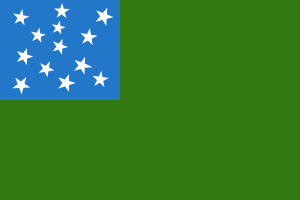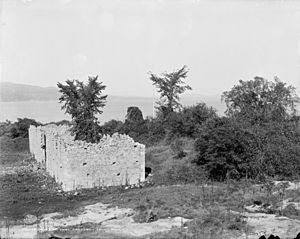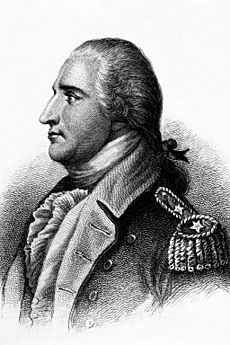Capture of Fort Ticonderoga facts for kids
Quick facts for kids Capture of Fort Ticonderoga |
|||||||
|---|---|---|---|---|---|---|---|
| Part of the American Revolutionary War | |||||||
An idealized depiction of Ethan Allen demanding the fort's surrender |
|||||||
|
|||||||
| Belligerents | |||||||
militia of the Connecticut Colony militia of the Province of Massachusetts Bay |
26th Regiment of Foot |
||||||
| Commanders and leaders | |||||||
| Ethan Allen Benedict Arnold |
William Delaplace |
||||||
| Strength | |||||||
| 83 at Ticonderoga 50 at Crown Point 35 at Saint-Jean |
48 at Ticonderoga 9 at Crown Point 21 at Saint-Jean |
||||||
| Casualties and losses | |||||||
|
1 captured near Fort Saint-Jean |
All captured | ||||||
The capture of Fort Ticonderoga was an important event in the American Revolutionary War. It happened on May 10, 1775. A small group of American fighters, known as the Green Mountain Boys, led by Ethan Allen and Colonel Benedict Arnold, surprised and captured the fort.
This fort was held by a small number of British soldiers. The Americans took many cannons and other weapons from Fort Ticonderoga. These weapons were later moved to Boston by Colonel Henry Knox. They were used to help the Americans win the siege of Boston.
Capturing Fort Ticonderoga was the first time Americans attacked the British in the war. After taking Ticonderoga, a small group also captured Fort Crown Point nearby. This happened on May 11. A week later, Arnold and 50 men raided Fort Saint-Jean in Quebec. They took military supplies, cannons, and the biggest ship on Lake Champlain.
Even though these were small battles, they were very important. They made it harder for British forces in the north and south to communicate. They also gave the new Continental Army a place to start their invasion of Quebec later that year. The cannons from Ticonderoga were key to forcing the British out of Boston.
Contents
Why Fort Ticonderoga Was Important
In 1775, Fort Ticonderoga was not as strong as it used to be. It had been very important during the French and Indian War. Back then, it guarded a main water route between two big empires. But after 1763, the French left North America. The fort was no longer on the border.
The French had damaged the fort when they left. It was falling apart. Only a small group of 48 British soldiers guarded it. Many of them were sick or injured. About 25 women and children also lived there. Even so, people still thought of Ticonderoga as a "gateway to the continent."
American Concerns About the Fort
Even before the war officially started, American leaders were worried about Fort Ticonderoga. The fort had many heavy cannons and other weapons. The Americans desperately needed these. The fort was also on Lake Champlain. This lake was a key route between the Thirteen Colonies and British-controlled Canada.
If the British made the fort strong again, they could attack American forces from behind. After the Battles of Lexington and Concord started the war, British General Thomas Gage realized the fort needed more protection. But several American colonists also had the idea to capture it first.
General Gage, who was stuck in Boston during the Siege of Boston, sent a letter. He told the governor of Quebec, General Guy Carleton, to fix up Fort Ticonderoga. However, Carleton did not get this letter until after the fort was already captured.
Arnold and Allen's Plans
Benedict Arnold knew the fort well from his travels. He knew it was not well-guarded and had many weapons. He told leaders in Boston about the fort. The Connecticut Committee of Correspondence decided to act. They raised money and recruited volunteers for an attack.
John Brown, an American spy, also knew the fort's value. Ethan Allen and other American supporters in the New Hampshire Grants (now Vermont) also saw its importance. They believed the fort should be taken if fighting started.
When Arnold reached Boston, he told the Massachusetts Committee of Safety about the fort's cannons. On May 3, the Committee made Arnold a colonel. They gave him permission to lead a "secret mission" to capture the fort. He was given money and supplies. He was told to recruit up to 400 men and send any useful weapons back to Massachusetts.
Gathering the American Forces
Arnold left right away. He rode quickly and reached the border of the New Hampshire Grants on May 6. There, he learned that the Connecticut Committee was also recruiting men. He found out that Ethan Allen and the Green Mountain Boys were already on their way north.
Arnold rode to Allen's headquarters in Bennington. He was told that Allen was in Castleton, about 50 miles (80 km) north. Allen was waiting for more men and supplies. Arnold was also warned that Allen's men would only follow Allen.
Arnold arrived in Castleton the next day. He joined a meeting where he argued that he should lead the attack. He had official permission from the Massachusetts Committee.
Allen's Green Mountain Boys
Allen had gathered about 100 Green Mountain Boys. He also had about 40 men from Pittsfield and 20 from Connecticut. Allen was chosen as the leader, or colonel.
Before the attack, Captain Noah Phelps went to the fort. He pretended to be a peddler. He saw that the fort's walls were weak. He also learned that the British soldiers' gunpowder was wet. He reported this information to Allen. This helped them plan a surprise attack at dawn.
Many of the Green Mountain Boys did not want Arnold to be in charge. They said they would go home if Allen was not the leader. Arnold and Allen then made an agreement. Some historians say Arnold was given joint command. Others believe he was only allowed to march next to Allen.
Capturing the Fort

By 11:30 PM on May 9, the men were ready to cross Lake Champlain. They were at Hand's Cove, in what is now Shoreham, Vermont. The boats did not arrive until 1:30 AM. There were not enough boats for everyone. Eighty-three Green Mountain Boys, along with Arnold and Allen, made the first trip.
As dawn approached, Allen and Arnold worried about losing the element of surprise. They decided to attack with the men they had. The only guard at the south gate ran away when his gun misfired. The Americans rushed into the fort.
The Patriots woke up the sleeping British soldiers. They took their weapons. Allen, Arnold, and a few others went to the officers' rooms. Lieutenant Jocelyn Feltham, an assistant to Captain William Delaplace, woke up. He asked who was entering the fort. Allen famously replied, "In the name of the Great Jehovah and the Continental Congress!"
Captain Delaplace came out and surrendered his sword. No one was killed in the battle. Only one American, Gideon Warren, was slightly hurt by a bayonet.
After the Capture
Eventually, about 400 American men arrived at the fort. They took liquor and other supplies. Arnold could not stop them because the Green Mountain Boys did not respect his authority. Arnold was frustrated. He wrote to the Massachusetts Provincial Congress. He said Allen and his men were "governing by whim and caprice." He worried that the plan to send weapons to Boston was in danger.
On May 12, Allen sent the captured British officers to Connecticut's Governor Jonathan Trumbull. Allen wrote, "I make you a present of a Major, a Captain, and two Lieutenants." Arnold spent the next few days listing all the military equipment at Ticonderoga and Crown Point.
Capturing Crown Point and Raiding Fort Saint-Jean
Seth Warner led a group up the lake and captured nearby Fort Crown Point. This fort was guarded by only nine men. This capture likely happened on May 11. A small group also captured Fort George on Lake George, which had only two soldiers.
More American troops, recruited by Arnold's captains, started to arrive. Some had captured a British ship, the Katherine, and several boats at Skenesboro. Arnold renamed the ship Liberty.
The captured British soldiers said that the only British warship on Lake Champlain was at Fort Saint-Jean. This fort was on the Richelieu River north of the lake. Arnold decided to try and capture this ship. He put guns on the Liberty and sailed north with 50 men on May 14.
Allen followed with some of his men, but Arnold's ships were faster. By May 17, Arnold's ships were at the north end of the lake. Arnold sent a scout to Fort Saint-Jean. The scout reported that the British knew about the fall of Ticonderoga. He also said that British troops were moving towards Saint-Jean. Arnold decided to attack right away.
Raid on Fort Saint-Jean
Arnold and 35 men rowed all night. They brought their boats close to the fort. They surprised the small group of soldiers there. They took supplies and a large British warship, HMS Royal George. Arnold renamed this ship the Enterprise.
They loaded the most valuable supplies and cannons onto the Enterprise. They sank any boats they could not take. Then, they sailed back to Lake Champlain. A retired British officer, Moses Hazen, saw this. He rode to Montreal to tell the military commander. He then went to Quebec City to tell General Carleton.
General Carleton immediately sent 140 men from Montreal to Saint-Jean. Fifteen miles out on the lake, Arnold's ships met Allen's boats. Allen's men had rowed 100 miles (160 km) without food. Arnold shared his supplies with them.
Allen believed he could take and hold Fort Saint-Jean. He continued north. Arnold sailed south. Allen reached Saint-Jean on May 19. He was warned that British troops were coming. Allen quickly returned to Ticonderoga on May 21, just as the British arrived. Three of Allen's men were left behind; one was captured.
What Happened Next

Ethan Allen and his men eventually left Ticonderoga. Arnold mostly managed things from Crown Point. He worked on getting the two large ships ready. He also helped rebuild Ticonderoga's barracks. His men worked to get weapons out of the fort's ruins and build new gun carriages for them.
Connecticut sent about 1,000 men under Colonel Benjamin Hinman to hold Ticonderoga. New York also started to raise soldiers to defend the forts. When Hinman's troops arrived in June, there was another disagreement over who was in charge. Arnold believed he was still in command.
The Massachusetts committee sent people to Ticonderoga. When they arrived on June 22, they told Arnold he had to serve under Hinman. After two days, Arnold gave up his command. He resigned and went home. He had spent over £1,000 of his own money to capture the fort.
When the American Congress heard the news, they sent a letter to the people of Quebec. This letter, and others, made many people in Quebec support the Americans.
When news of Ticonderoga's fall reached England, Lord Dartmouth said it was "very unfortunate; very unfortunate indeed."
Impact in Quebec
News of the capture of Ticonderoga and Crown Point, and the raids on Fort Saint-Jean, shocked the people of Quebec. Colonel Dudley Templer, in charge of Montreal's soldiers, asked people to join a militia. He also asked local Native Americans to help.
Only 50 men, mostly French landowners, joined the militia in Montreal. No Native Americans came to help. Templer also stopped merchants who supported the Americans from sending supplies south.
General Carleton ordered soldiers from Montreal and Trois-Rivières to make Fort Saint-Jean stronger. Some troops from Quebec City were also sent there. Carleton then went to Montreal to lead the defense of the province. He left Quebec City in the hands of Lieutenant Governor Hector Cramahé.
Later Events Near Ticonderoga
In July 1775, General Philip Schuyler used Fort Ticonderoga as a base. From here, the invasion of Quebec began in late August.
In the winter of 1775–1776, Henry Knox led the amazing transportation of the guns from Ticonderoga to Boston. These cannons were placed on Dorchester Heights. This spot overlooked Boston and the British ships in the harbor. This forced the British to leave Boston in March 1776.
Benedict Arnold later led ships in the Battle of Valcour Island. He also helped stop Britain from taking back the fort in 1776. The British did recapture the fort in July 1777 during the Saratoga campaign. But they left it by November after Burgoyne's surrender at Saratoga.
Communication Problems

Even though Fort Ticonderoga was not a major military post at the time, its capture had big results. American control of the area meant that British communication and supply lines were cut. This affected British forces in Quebec, Boston, and later New York.
Arnold even intercepted a message from Carleton to Gage. This message detailed the British troop strengths in Quebec. Because of this, the British military command changed. Command of British forces in North America was split into two. General Carleton led forces in Quebec. General William Howe led forces along the Atlantic coast. This split caused problems later. It played a role in the failure of the Saratoga campaign in 1777. General Howe did not provide support to General John Burgoyne in that campaign.
Allen and Arnold's Disagreements
From the day the fort was captured, Allen and Arnold argued. Each wanted to get the most credit for the operation. Arnold could not control Allen's men. He started writing a diary that was very critical of Allen.
Allen also began writing his own story. When it was published years later, it did not even mention Arnold. Allen wrote several versions of the events. These were sent to different American committees. Some historians believe that Arnold's version was purposely lost. This made Allen's story, which made him look very heroic, the main one.
There were many arguments between Arnold and Allen's men. At times, some of Allen's men even pulled out their weapons.
See also
 In Spanish: Captura del Fuerte Ticonderoga para niños
In Spanish: Captura del Fuerte Ticonderoga para niños



